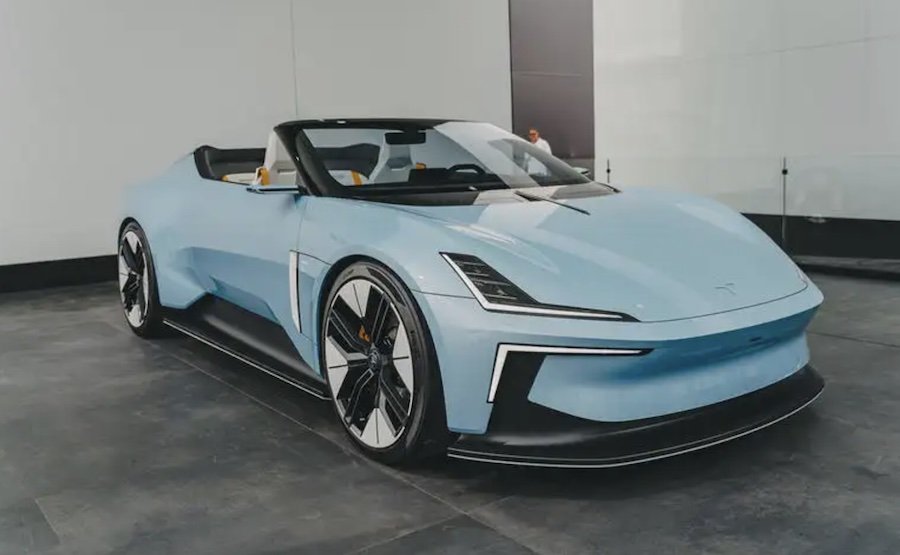New 2026 Polestar 6 confirmed as 874bhp evolution of O2 concept

When Polestar revealed its jaw-dropping O2 convertible concept earlier this year, CEO Thomas Ingenlath said that it would be “irresponsible” not to launch a production version of the electric drop-top sports car. Following an “overwhelming” consumer response, the firm will now do just that.
Expected in 2026, the production version, which will be called the Polestar 6, will keep the concept’s folding hard-top and use the same bonded aluminium platform as the Polestar 5 grand tourer, which is due a year earlier. It will also share that car’s 800V charging architecture and twin-motor, four-wheel-drive powertrain, which produces 874bhp and 663lb ft for a 3.2sec 0-62mph time and a 155mph top speed.
The 6 will arrive as one of just a handful of dedicated two-seat sports EVs due in the coming years from brands including Alpine, Lotus, MG and Porsche, although it looks set to place more of an emphasis on long-distance refinement and luxury.
Polestar will reveal full details over the next four years, but it has already started offering build slots to interested customers. It has also confirmed a run of 500 LA Concept editions of the 6, which will feature the same colour scheme and bespoke 21in wheels as the O2 concept, which made its public debut in June at the Goodwood Festival of Speed.
As it is based on an adapted version of the aluminium architecture that has been developed by Polestar’s UK engineering base in Warwickshire for the forthcoming Polestar 5, it should offer comparable “supercar levels” of body stiffness.
The O2 takes design cues from the Precept concept – which previewed the 5 – and Ingenlath said it was developed with two goals: further reinforcing the brand’s image as a “luxury sports brand”, and pushing internal development.
“The energy and vision that it brings into the company definitely drives us,” said Ingenlath. “We made the Precept a reality with the Polestar 5, and that’s the result of us daring to go out with that vision", he said, before adding it would be “irresponsible” not to push to put it into production in the future.
Asked by Autocar if the O2 will lead to a production version, Ingenlath said: “From packaging and how it’s constructed, it’s possible to put such a car in production.” He added: “Our concept cars breed that spirit of being tangible and realistic.”
He added that an electric roadster is "a great missed opportunity, and I would love to grab that opportunity", and that drivers would not miss the noise of a combustion engine: "The propulsion of an electric drivetrain is great for a sports car. And then to do it when an open-roof concept, when everybody dreams about ‘the fresh air, the breeze, being closer to nature’ - it’s a perfect fit to have that with an electric drivetrain, and not only have fresh air when you arrive at it, but you’ll leave it for the people behind you.
“Electric propulsion is absolutely a perfect fit for a roadster, so I would love to put an exclamation mark that the future of driving an open roadster has to be electric.”
The O2, which features a fixed retracting roof, is substantially shorter than the 5, at around 4600mm long, with the wheelbase shrunk by around 400mm. This has been enabled by removing the ‘foot garage’ – a well in the skateboard chassis floor of the 5 to increase rear leg room – from the platform. Polestar claims this will allow the model to maintain huge rigidity, ensuring it offers strong handling and dynamics.
The concept sits on 22in wheels and features aerodynamically sculpted bodywork that is designed to maximise range by improving airflow and reducing turbulence behind the vehicle.
The O2 has also been created with a focus on sustainability in terms of design and materials, notably with a new thermoplastic mono-material used as the base for various components, and the use of recycled polyester for all the soft interior materials. Polestar says the machine makes use of recycled materials where possible, including in the aluminium shells.
The focus on sustainability has included learning from Polestar’s project to develop a truly zero-emission car by 2030. Design chief Maximilian Missoni said: “We’ve put some of the ideas we’ve developed from Project Zero into the O2 to say, ‘look, we can do products that are highly emotional and aspirational and still take people towards that goal towards zero emissions'. It’s not like we’re going to enjoy ourselves as long as we can and then switch to tiny zero-emission cars: we can do both.”
The O2 also contains a novel feature: an autonomous cinematic drone, developed by Hoco Flow, which can be deployed when the car is moving to record driving sequences. An aerofoil behind the rear seats raises with the roof down to create a calm area of negative pressure that will allow the drone to launch while the car is moving, and it can follow the car at speeds up to 56mph.
Asked if the O2 could be mechanically linked to future models from Geely-owned sibling brand Lotus, Ingenlath said: "The O2 highlights what we created for the Polestar 5. This aluminium frame is Polestar-developed and serves other purposes, being able to have this grand, luxurious GT on there in the Polestar 5.
"This concept we designed for Polestar, and every brand in the Geely group would like to use it and we are open to cooperation. But it has to serve the purpose of the brand, and I cannot talk here for other brands of the Geely group. When it comes to powertrain, us developing a powerful electric engine for top-line performance, this is technology that is not just solely interesting for the Polestar brand but that we consider sharing within the Geely Group."
